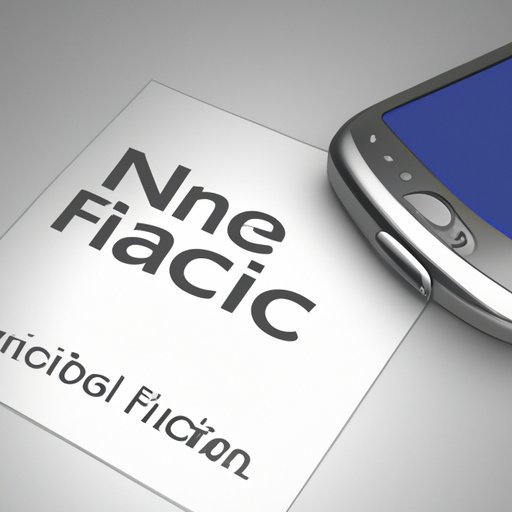Introduction
Near-field communication (NFC) is a technology used to enable wireless communication between two devices over a short distance. NFC allows users to transfer data quickly and easily without the need for cables or wires. It has become increasingly popular in recent years due to its convenience and wide range of applications, particularly in mobile devices such as smartphones.
In this article, we will explore what NFC is and how it works on smartphones. We will also provide an overview of the benefits of having NFC on your phone, a guide to using NFC on your device, a comparison of NFC vs Bluetooth, security concerns with NFC on phones, and tips for getting the most out of NFC on your device.

A Guide to Using NFC on Your Phone
Before you can start taking advantage of NFC on your device, you’ll need to make sure that it is activated. On most Android devices, you can do this by going to Settings > Connections > NFC and Payment > Turn on NFC. For Apple devices, you can go to Settings > Wallet & Apple Pay > Turn on NFC.
Once you have NFC enabled on your device, there are a variety of uses for it. One of the most common is for contactless payments. With NFC, you can use your phone to pay for goods and services at participating stores. This is often faster and more secure than traditional methods of payment, as it eliminates the need for cash or cards.
You can also use NFC to exchange data between two devices. This could be useful for transferring photos, videos, documents, or other types of files. Additionally, you can use NFC to pair your device with other compatible devices, such as speakers or headphones.

NFC vs Bluetooth: Comparing the Two Technologies
When it comes to wireless communication, NFC and Bluetooth are two of the most popular technologies. While they both offer similar benefits, there are some important differences between them.
The main difference between NFC and Bluetooth is their range. NFC operates over a very short range, usually just a few centimeters, while Bluetooth has a much longer range of up to 100 meters. As a result, NFC is better suited for quick, one-time data transfers, while Bluetooth is better for continuous communication over a longer period of time.
Another important difference is the amount of power required. NFC requires very little power, so it can be used for small, low-power tasks such as contactless payments. Bluetooth, on the other hand, requires more power and is better for tasks that require more bandwidth, such as streaming audio or video.
Finally, NFC is generally considered to be more secure than Bluetooth. This is because NFC operates over a shorter distance, which makes it harder for malicious actors to intercept data. However, this does not mean that NFC is completely secure, as there are still potential security risks that should be taken into consideration.
Security Concerns with NFC on Phones
While NFC offers several advantages over other forms of wireless communication, it is important to be aware of potential security risks. One of the biggest risks is that someone could use an NFC-enabled device to gain access to your personal data without your knowledge or consent.
To protect yourself from these threats, it is important to take precautions when using NFC on your device. Make sure that you only use secure networks when transferring data, and avoid connecting to public Wi-Fi networks. Additionally, be sure to keep your device’s software up to date, and be aware of any suspicious activity on your device.

Tips for Getting the Most Out of NFC on Your Device
Now that you have a better understanding of NFC and how it works on mobile devices, here are some tips for getting the most out of this technology:
First, be sure to take advantage of all the features that NFC offers. From contactless payments to data sharing and pairing, there are many ways to make use of NFC on your device.
Second, if you plan on using NFC for payments, be sure to take the necessary steps to ensure your security. This includes enabling two-factor authentication, using secure networks, and keeping your device updated with the latest security patches.
Finally, consider using NFC tags or stickers to automate certain tasks. You can program NFC tags to do things like turn on Wi-Fi, launch an app, or even unlock your device. This can save you time and make your life easier.
Conclusion
NFC is a powerful technology that can be used for a variety of applications, from contactless payments to data sharing and automation. It is important to understand the benefits and potential security risks of using NFC on your device, as well as how to get the most out of this technology. By following the tips outlined in this article, you can make the most of NFC on your device and enjoy its many benefits.


